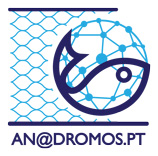THE HISTORY OF ANADROMOUS FISHERY
Fishing communities of anadromous fish, like allis shad and sea lamprey, also dedicate their activity to other species, or have other activities, due to the seasonal nature on the occurrence of these halieutics resources.
This type of fishery has a very important and increased socio-cultural value for many communities. During fishing season, a countless number of gastronomical festivals take place in Portugal, promoting towns and their mores. This cultural value increases with the differences in the arts and methods of fishing, with unique and intrinsic characteristics for each different fishing community.
Drift trammel is generally the most common fishing art. It consists of a three-part net, dropped by a fishing vessel and kept vertical while it is dragged by the tide. This method is used to capture both allis shad and sea lamprey.
Cambôa – or Botirão – is a fixed fishing art, used in the capture of sea lamprey. It consists of a conic pouch of net and hoops, fixed to the riverbed by stakes and nets that help guide the fish to the trap. This art has small variations from community to community according to the characteristics of their water courses.
INTEGRATED MANAGEMENT IN FISHERIES – CO-MANAGEMENT
The Operational Plan for the Monitoring and Management of Anadromous Fish in Portugal advocates for the implementation of an integrated management system and co-management of commercial fishing activities.
Co-management is defined by “a set of agreements with different degrees of power sharing, allowing for the joint decision making of the government and the users over a group of resources or areas”.
Co-management and integrated management in fisheries allows for fishery sustainability to be achieved by involving fishermen, scientists, administrative and fiscal entities.
Sustainability is achieved by the union of its three defining pillars: Environmental, Economic and Social. Integrated management in fishing allows involvement of every person who represents each of these pillars, promoting a balanced resource exploitation at all levels.
By sharing knowledge between fishermen and scientists, it is possible to establish policies that lead to the social-economic wellbeing of the sector, while maintaining a good environmental status of resources. This is a step in the direction of achieving the sustainability goals of the Common Fisheries Policy (CFP) and the Framework Directive Marine Strategy (FDMS).
SUSTAINABLE CONSUMPTION AND TRACEABILITY OF FISHING PRODUCTS
Fish and its derived products are amongst the most transitioned goods in the world.
Consumers are progressively more informed and exigent, and this is reflected in the fishing industry, as it becomes more complex and dynamic, highly segmented and diversified, to satisfy these high standards. The value chain is complex, and poor traceability of fish leads to bad decision making on the consumers end, due to absence of information, mostly about the origin of these products.
Anadromous fishing in Portugal is mostly done in small scale fisheries, with little relevance on a national level, but with massive local impact. Small scale fisheries are very important in supplying the local markets with fresh fish, therefore generating local income, and the value chain is relatively small, as few entities are involved in its distribution (fishermen, intermediary/market and consumer). As such, it contributes to a higher food security, as the origin of the product is known, and the fish is fresh.
Certification is within the most common initiatives to promote and differentiate products that result from small scale fisheries, be it through Sustainability Certification, or by the creation of Labels of Origin.
Certification of local products, allied with campaigns that increase their presence in regional and local markets, are a powerful tool to promote the consumption of species of high economic importance for small scale fisheries – like sea lamprey and allis shad. Valuing these products, by certifying them, increases the value chain’s profitability.
Certification, differentiation and valorisation initiatives, like those presented in this project for small scale and inland waters fisheries, will contribute to:
- Increase the option for traditional catch methods by involved markets – i.e. restaurants, consumer;
- Increase product value in market;
- Improve traceability of fishing products;
- Increase profitability and viability of fisheries;
- Improve governance and sustainability of small-scale fisheries.

